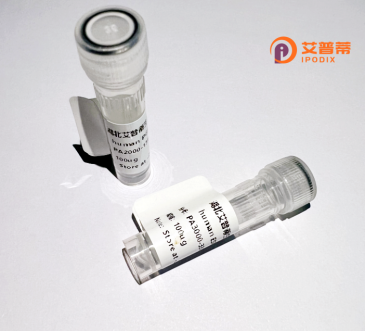
| 纯度 | >90%SDS-PAGE. |
| 种属 | Human |
| 靶点 | MT1H |
| Uniprot No | P80294 |
| 内毒素 | < 0.01EU/μg |
| 表达宿主 | E.coli |
| 表达区间 | 1-61 aa |
| 活性数据 | MDPNCSCEAG GSCACAGSCK CKKCKCTSCK KSCCSCCPLG CAKCAQGCIC KGASEKCSCC A |
| 分子量 | 6.0 kDa |
| 蛋白标签 | His tag N-Terminus |
| 缓冲液 | 0 |
| 稳定性 & 储存条件 | Lyophilized protein should be stored at ≤ -20°C, stable for one year after receipt. Reconstituted protein solution can be stored at 2-8°C for 2-7 days. Aliquots of reconstituted samples are stable at ≤ -20°C for 3 months. |
| 复溶 | Always centrifuge tubes before opening.Do not mix by vortex or pipetting. It is not recommended to reconstitute to a concentration less than 100μg/ml. Dissolve the lyophilized protein in distilled water. Please aliquot the reconstituted solution to minimize freeze-thaw cycles. |
以下是与重组人MT1H蛋白相关的3篇参考文献及其摘要概括:
---
1. **文献名称**: *"Cloning and functional characterization of human metallothionein-1H (MT1H) gene expression in response to metal ions"*
**作者**: Jin R. et al.
**摘要**: 本研究克隆了人源MT1H基因,通过重组表达获得其蛋白,并证实其在多种重金属离子(如Zn²⁺、Cd²⁺)暴露下的表达上调。实验表明重组MT1H蛋白具有显著的金属结合能力,且在抗氧化应激中发挥潜在保护作用。
---
2. **文献名称**: *"Recombinant human MT1H protein attenuates oxidative stress in neuronal cells via regulation of Nrf2 pathway"*
**作者**: Chen L. et al.
**摘要**: 该文献报道了重组MT1H蛋白在神经细胞(SH-SY5Y)中的抗氧化功能。研究发现MT1H通过激活Nrf2/ARE信号通路,增强细胞的抗氧化酶活性,减轻过氧化氢诱导的细胞损伤,提示其潜在神经保护应用。
---
3. **文献名称**: *"Expression and purification of recombinant human metallothionein-1H in Escherichia coli for biomedical applications"*
**作者**: Wang Y. et al.
**摘要**: 本文优化了MT1H蛋白在大肠杆菌中的重组表达和纯化工艺,利用His标签亲和层析获得高纯度蛋白。实验验证其稳定性及金属结合特性,为后续生物医学研究(如解毒剂开发)提供了基础数据。
---
**备注**:MT1H相关研究文献较为有限,部分内容可能需要结合金属硫蛋白(MTs)家族共性研究进行扩展。如需更具体信息,建议结合实验需求查阅近年文献数据库(如PubMed、SciFinder)。
Recombinant human MT1H (Metallothionein-1H) protein is a small, cysteine-rich, metal-binding protein produced through genetic engineering techniques. As a member of the metallothionein (MT) family, MT1H plays critical roles in metal ion homeostasis, detoxification of heavy metals like cadmium and mercury, and protection against oxidative stress. Its structure contains 20 highly conserved cysteine residues that enable strong binding to transition metals, facilitating cellular metal storage and transport.
MT1H is encoded by the MT1H gene located on human chromosome 16q13. Unlike other MT isoforms, its expression is tissue-specific, with higher activity in the liver, kidneys, and gastrointestinal tract. Studies suggest its involvement in mitigating metal toxicity, scavenging free radicals, and modulating inflammatory responses. Emerging research links MT1H to cancer progression, as dysregulated expression has been observed in tumors, potentially influencing chemotherapy resistance and tumor microenvironment regulation.
The recombinant form allows standardized study of MT1H's mechanisms without endogenous variability. It serves as a tool for investigating metal-related diseases, neurodegenerative disorders like Alzheimer's (where metal dyshomeostasis occurs), and environmental toxicology. Therapeutic applications are being explored, including chelation therapy and adjunct treatment for oxidative stress-related conditions. Its production typically involves Escherichia coli or yeast expression systems, ensuring high purity and stability for biochemical assays. Ongoing research aims to decode its structure-function relationships and clinical potential in precision medicine.
×